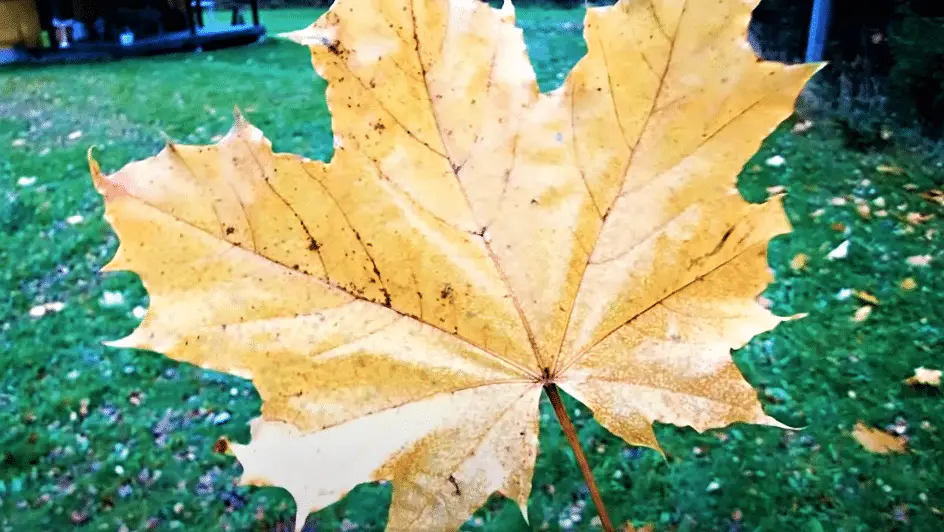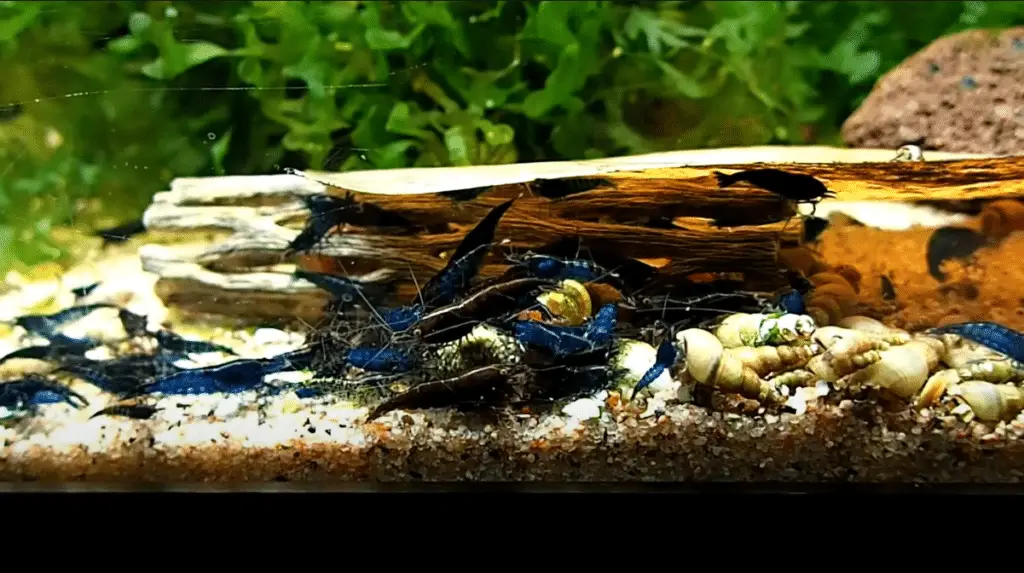Aquarium hobbyists often ask how long can shrimp go without food? Before going on vacation or holiday . Shrimp have short digestive tracts and a constant need for food, so it is crucial to create a self-sustaining tank environment that provides a continuous nourishment supply.
. Shrimp have short digestive tracts and a constant need for food, so it is crucial to create a self-sustaining tank environment that provides a continuous nourishment supply.
In this comprehensive guide, we’ll delve deeper into the tank setup and introduce a variety of leaves, wood, and other food sources, including snowflake shrimp food, to ensure your shrimp will thrive even in your absence.
The Importance of a Self-Sustaining Shrimp Tank Environment
Creating a self-sustaining tank environment is essential for your shrimp’s survival during your vacation. This involves providing a variety of food sources, hiding places, and structures that will allow your shrimp to graze and forage continuously. Let’s explore each element in more detail:
- Substrate: Choose a nutrient-rich substrate, such as aqua soil or sand, to encourage the growth of microorganisms and provide a suitable environment for shrimp to sift through in search of food particles.
- Filters: A well-functioning filter will maintain water quality and provide an additional food source in the form of biofilm – a thin layer of microorganisms that forms on filter media and is a nutritious snack for shrimp
 .
. - Live plants: Aquatic plants offer numerous benefits, including oxygenation, water purification, and shelter. They also produce biofilm, shed leaves, and serve as a valuable food source for shrimp. Consider incorporating plants like Java moss, Anubias, and Java fern into your tank.
- Driftwood and rocks: Adding driftwood, rocks, or other structures will create hiding places for shrimp while promoting the growth of biofilm
 , algae, and microorganisms for them to graze on. Choose materials that are aquarium-safe, such as Malaysian driftwood, spider wood, or lava rocks.
, algae, and microorganisms for them to graze on. Choose materials that are aquarium-safe, such as Malaysian driftwood, spider wood, or lava rocks. - Decaying leaves: Various types of leaves provide both shelter and a food source for shrimp
 as they decompose. Leaves release tannins, which improve water quality, and serve as a grazing ground for shrimp. Consider adding Indian almond leaves, oak leaves, mulberry leaves, beech leaves, or maple leaves to your tank.
as they decompose. Leaves release tannins, which improve water quality, and serve as a grazing ground for shrimp. Consider adding Indian almond leaves, oak leaves, mulberry leaves, beech leaves, or maple leaves to your tank.
Holiday Feeding Options For Your Aquarium
When you are away, it is crucial to provide additional food sources that will last longer and ensure your shrimp remain well-fed. One excellent option is snowflake shrimp food , which is made from the hull of soybeans. This food decomposes slowly, providing a long-lasting source of nourishment for your shrimp while you are on vacation. Other options include:
, which is made from the hull of soybeans. This food decomposes slowly, providing a long-lasting source of nourishment for your shrimp while you are on vacation. Other options include:
- Commercial slow-release food: These products are designed to provide a steady supply of nutrients over an extended period. Follow the manufacturer’s guidelines for the appropriate amount to add to your tank.
- Vegetable-based foods: Blanched vegetables like zucchini, spinach, or cucumber can be placed in the tank before leaving. These foods will break down slowly and provide a continuous food source for your shrimp.

What Other Preparations Can I Do Before I Go On Holiday?
Before going on vacation, preparing your aquarium to ensure your shrimp and other aquatic inhabitants remain healthy and well-cared for during your absence is essential. Here are some steps you can take to prepare your tank:
- Perform a water change: A few days before you leave, perform a water change (around 20-30% of the tank volume) to maintain water quality and stability.
- Check equipment: Inspect your aquarium equipment, such as filters, heaters, and air pumps, to ensure they are functioning properly.
- Clean the filter and replace any worn-out parts.
- If necessary, Test water parameters: Test the water for ammonia, nitrite, nitrate
 , pH, and other essential parameters to ensure they are within the appropriate range for your shrimp and other inhabitants.
, pH, and other essential parameters to ensure they are within the appropriate range for your shrimp and other inhabitants. - Automate lighting: Set up a timer for your aquarium lights to maintain a consistent day-night cycle, which is essential for both shrimp and plants. (I have my lights on for 12 hours a day)
- Install an automatic feeder: If you will be away for an extended period, consider using an automatic feeder to dispense food at regular intervals. Make sure to test the feeder before leaving to ensure it functions properly.
- Prepare a backup plan: In case of equipment failure or other emergencies, ask a friend, neighbor, or professional aquarium caretaker to check on your tank periodically. Provide them with clear instructions on handling emergencies and your contact information.
- Avoid adding new inhabitants: Do not introduce any new shrimp, fish, or plants to the aquarium shortly before leaving, as this could cause stress or lead to unforeseen issues.
- Top off the water: If your tank is prone to evaporation, top off the water before you leave to maintain a stable water level.
- Feed long-lasting food: As previously mentioned, add long-lasting food sources such as snowflake shrimp
 food, slow-release food blocks, or blanched vegetables to your tank to ensure your shrimp have enough food during your absence.
food, slow-release food blocks, or blanched vegetables to your tank to ensure your shrimp have enough food during your absence. - It’s important to avoid overfeeding your shrimp before leaving for your vacation. Overfeeding can lead to poor water quality, algae blooms, and other issues that can be harmful or even fatal to your shrimp and other tank inhabitants.
How Long Can I Realistically Leave The Shrimp For?
The length of your vacation and its impact on your shrimp and aquarium will depend on several factors, such as the stability of your tank, the availability of food sources, the size and species of shrimp, and the backup plans you have in place.
Generally, shrimp can be left unattended for about 1-2 weeks without major issues, especially if you have a well-established, self-sustaining tank with ample natural food sources like biofilm, algae, and live plants.
For vacations longer than two weeks, having someone check on your aquarium periodically is advisable. This person should be responsible and ideally have experience with aquarium care. Provide them with detailed instructions on feeding, monitoring water parameters, and handling emergencies.
With proper planning and preparation, it is possible to go on vacation for up to three to four weeks without major concerns, as long as you have someone checking on your tank and taking care of your shrimp as needed.

Can I Treat Cherry Shrimp And Crystal Red Shrimp The Same On This Advice?
Yes, the advice provided in this discussion can generally be applied to both Cherry shrimp (Neocaridina davidi) and Crystal Red shrimp (Caridina cantonensis). Both species require a stable, well-maintained environment with proper water parameters, filtration, and a balanced diet to thrive.
(Neocaridina davidi) and Crystal Red shrimp (Caridina cantonensis). Both species require a stable, well-maintained environment with proper water parameters, filtration, and a balanced diet to thrive.
Can shrimp only survive on algae?
No, shrimp cannot survive on algae alone. While some species of shrimp do feed on algae, they also require a balanced diet that includes other types of food such as small aquatic animals, detritus (dead organic matter), and plankton.
In an aquarium setting, it’s important to provide shrimp with a varied diet to ensure they receive all the necessary nutrients for their health and survival. This can be achieved through feeding them specialized shrimp pellets or flakes, as well as fresh or frozen foods such as bloodworms, brine shrimp, and vegetables like spinach or zucchini.
In the wild, shrimp will feed on a variety of organisms found in their habitat, which can include small fish, insect larvae, and other crustaceans. Their diet will vary depending on the species of shrimp and the environment in which they live.
Conclusion
In conclusion, with proper planning and tank setup, you can confidently go on vacation without worrying about the well-being of your Cherry shrimp, Crystal Red shrimp, or other shrimp species. By incorporating various food sources, structures, aquatic plants, and even algae, you will create a self-sustaining environment that ensures your shrimp remain healthy and well-fed, even in your absence.
Feeding shrimp during your vacation can be managed by considering additional holiday feeding options, like snowflake shrimp food, which will help keep your shrimp thriving while you enjoy your time away. Remember to also provide sufficient substrate and water for your shrimp, taking into account their preferred water parameters and temperature ranges.
during your vacation can be managed by considering additional holiday feeding options, like snowflake shrimp food, which will help keep your shrimp thriving while you enjoy your time away. Remember to also provide sufficient substrate and water for your shrimp, taking into account their preferred water parameters and temperature ranges.
If you have someone checking on your tank during your vacation, ensure they are familiar with the unique needs of each species and provide them with clear instructions. This may involve discussing specific care requirements, such as dwarf shrimp or red cherry shrimp care, and sharing information about potential issues, such as rotting food in the aquarium or adjusting the tank’s accessories.
It’s essential to take the time to properly prepare your aquarium before leaving and ensure that you have someone reliable to check on your tank if you’ll be away for an extended period. By following the advice outlined in this guide, you can create a self-sustaining environment that caters to the needs of your shrimp, whether they are Cherry shrimp, Crystal Red shrimp, or other species. This will not only help them thrive in your absence but also contribute to the overall health and stability of your aquarium.
It’s crucial to remember that each shrimp species has unique requirements, so always research the specific care guidelines for the shrimp you have in your tank
FAQ How long can shrimp go without food?
Q: How long can shrimp go without food?
A: Shrimp can generally survive without direct feeding for 1-2 weeks in a well-established, self-sustaining tank with ample natural food sources like biofilm, algae, and live plants.
Q: What can I do to prepare my shrimp tank for my vacation?
A: Ensure a self-sustaining environment with a nutrient-rich substrate, live plants, driftwood, rocks, and decaying leaves. Add long-lasting food sources like snowflake shrimp food or blanched vegetables before leaving.
food or blanched vegetables before leaving.
Q: Do I need someone to check on my shrimp tank while I’m on vacation?
A: For vacations longer than two weeks, it’s advisable to have someone check on your aquarium periodically. Choose a responsible person, preferably with aquarium care experience, and provide them with clear instructions.
Q: Can I rely on algae as the primary food source for my shrimp?
A: While algae can provide some nutrients, it’s not ideal as the sole food source. Ensure a balanced diet for your shrimp by providing biofilm, commercial shrimp food, live or frozen foods, blanched vegetables, and decaying leaves.
Q: Can the same advice be applied to Cherry shrimp and Crystal Red shrimp?
shrimp?
A: Yes, the advice provided can generally be applied to both Cherry shrimp (Neocaridina davidi ) and Crystal Red shrimp (Caridina cantonensis). Ensure you meet the specific care requirements for each species, including water parameters and temperature ranges.
) and Crystal Red shrimp (Caridina cantonensis). Ensure you meet the specific care requirements for each species, including water parameters and temperature ranges.
